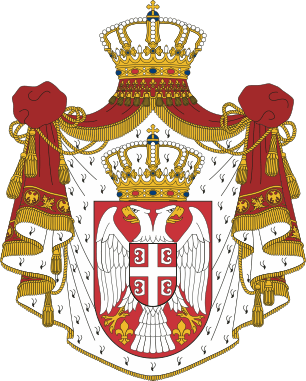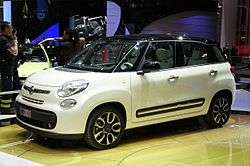Automotive industry in Serbia
| Economy of Serbia |
|---|
 |
| Overview |
| Sectors |
| Serbia topics |
|
Serbia's automotive industry is one of the most important industrial sectors and makes about 15% of industrial output of the country and 18% of all exports (expected to reach $2 billion in 2013).[1]
History
The Serbian automotive industry has a tradition of more than 70 years, within the existence of Yugoslavia, dating back to 1939 in the city of Kragujevac, where Zastava, the Yugoslavian/Serbian producer of motor vehicles, manufactured various models of automobiles under the license of FIAT.
Zastava's suppliers manufactured under strict, high-quality production standards that enabled them to work with other western car manufacturers such as Mercedes, Ford, Peugeot Citroën-PSA Renault,and Opel.
Today, the automotive industry is one of the most prominent sectors in Serbia, accounting for almost 10% of the entire FDI stock in Serbia since 2000. 27 international investors have invested almost €1.5 billion in the sector, creating more than 19,000 jobs. The Serbian automotive industry supplies almost all major European and some Asian car manufacturers.[2]
The manufacturing of vehicle chassis system parts, especially tires and suspension parts is the most prominent activity in the industry. Electrical system components are another dominant product group with car batteries and wiring installations as the most important products. Also, the production of engine components, mostly cast, is very significant, along with forged and machined parts like camshafts, brake discs, valves and flywheels.
Among these manufacturing companies are: Tigar Tyres, Leoni Wiring Systems Southeast, Yura Corporation, Cooper Tire & Rubber Company Serbia, Trayal Corporation and IGB Automotive.
Active manufacturers
FCA Srbija

In 2008, FIAT entered a Joint Venture (JV) with the Republic of Serbia, creating what would become known as FCA Srbija. The JV extensively renovated and remodeled the former headquarters facility and assembly plant of Zastava Automobiles, and now manufactures the Fiat 500L,[3][4] with an annual capacity of 85,000 cars (as of 2016).[5]
Ikarbus

Ikarbus is a bus manufacturer based in Belgrade. The company was first founded in 1923 as an aircraft manufacturer. After World War II the company was nationalised and two other Serbian aircraft manufacturers, Rogožarski and Zmaj aircraft, were merged into Ikarus. However, during the 1950s most of the personal and infrastructure of the aircraft factory were relocated to SOKO, and since then Ikarus has focused completely on bus production, first under licence, originally with Sauer and MAN designs, and later with the company's own designs. In 1992 the company was privatized, but due to a name dispute with Hungarian bus manufacturer Ikarus Bus,it changed name to Ikarbus.
FAP
In 1952 Fabrika automobila Priboj (FAP) was founded and a year later the first trucks were produced based on a licence from Saurer. First domestically designed vehicles where introduced in serial production by 1965. In 1970 a production, technical and financial cooperation contract was signed by FAP with Daimler-Benz. In 1978 FAP began its collaboration with the Military Technical Institute Belgrade and started developing and producing special military vehicles. Since the 2010-s, FAP has military oriented and heavily limited production.
BIK
Bus industries Kragujevac (BIK), in collaboration with Belorussian truck and bus manufacturer MAZ, began production by the late 2000s of gas-powered buses named BIK-203 which are based on the platform of the MAZ-203 model.[6][7] These buses have been delivered to several Serbian towns to be in use in public transportation companies
Defunct manufacturers
IDA-Opel
IDA-Opel was a car manufacturer based in Kikinda which produced Opel models under license between 1977 and 1992.
Neobus
Neobus was a bus manufacturer based in Novi Sad. Founded in 1952 as Autokaroserija, they cooperated closely with Slovenian manufacturer TAM. In 1992, with the independence of Slovenia, the cooperation ended and Autokaroserija became an independent bus manufacturer and changed its name to Neobus. In 2012 the Neobus went into bankruptcy.
IMT
Industry of Machinery and Tractors (IMT) has produced tractors and agricultural machinery since the 1950s. It went into bankruptcy procedure in 2016.[8] Production is expected to be reactivated.[9]
Zastava Automobiles
Group Zastava Vehicles with its main company Zatava Automobiles, is a Serbian car manufacturer founded in Kragujevac, SFR Yugoslavia in 1953 as a successor to a Yugoslavian truck manufacturer. After decades of manufacturing numerous passenger and commercial vehicles under the Zastava brand, in 2008, the company ended production and in 2017, the company declared bankruptcy.
In 2008, Zastava's headquarters and assembly facilities were extensively renovated and modernized when they were assumed in a joint venture with the Republic of Serbia and Fiat, eventually becoming FCA Srbija.
References
- ↑ http://www.b92.net/biz/vesti/srbija.php?yyyy=2013&mm=10&dd=04&nav_id=761347
- ↑ http://siepa.gov.rs/en/index-en/key-industries/automotive.html
- ↑ "Fiat Investing $1b into Zastava". Macedoniaonline.eu. Retrieved 2008-11-29.
- ↑ http://www.b92.net/info/vesti/index.php?yyyy=2010&mm=09&dd=11&nav_id=458131
- ↑ "Fiat proizveo 85.000 automobila u Kragujevcu u 2016. - Isti kapaciteti očekuju se i 2017. godine". ekapija.com (in Serbian). Beta. 15 December 2016. Retrieved 8 February 2018.
- ↑ Gas-powered bus from Kragujevac at ekapija.rs, 20-4-2009
- ↑ MAZ-BIK 203 at Vulović Transport official website
- ↑ http://www.danas.rs/ekonomija.4.html?news_id=325150&title=Fabrika%20likvidirana%20zarad%20interesa%20tajkuna%20i%20uvozni%C4%8Dkog%20lobija
- ↑ https://insajder.net/sr/sajt/tema/7316/